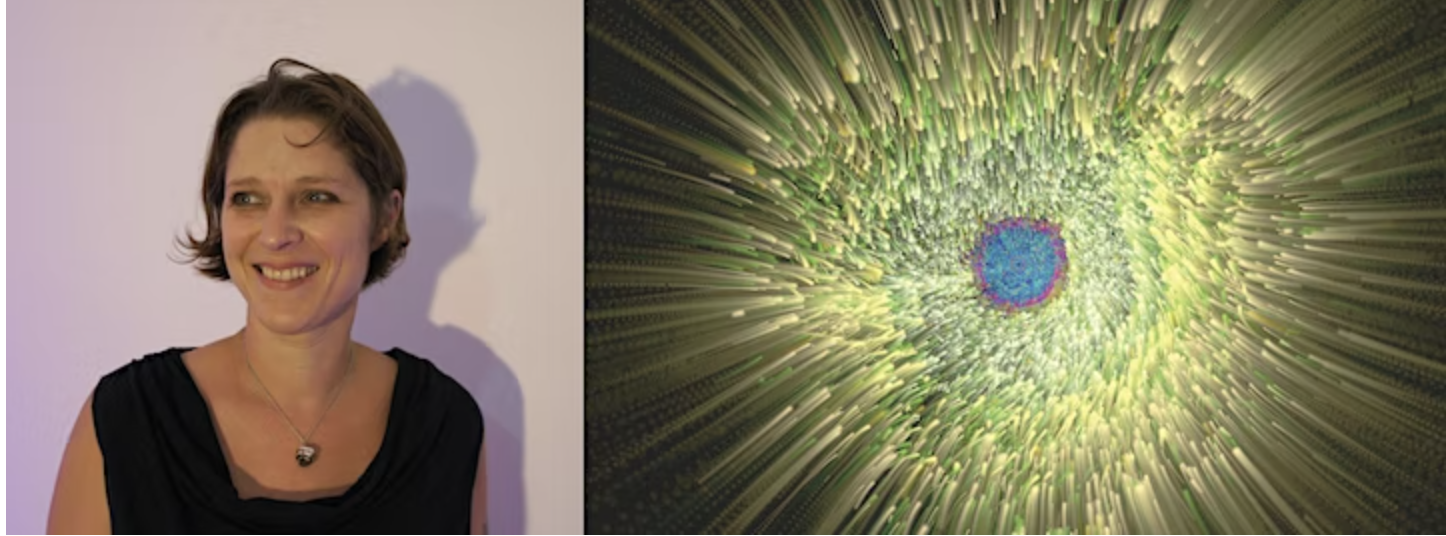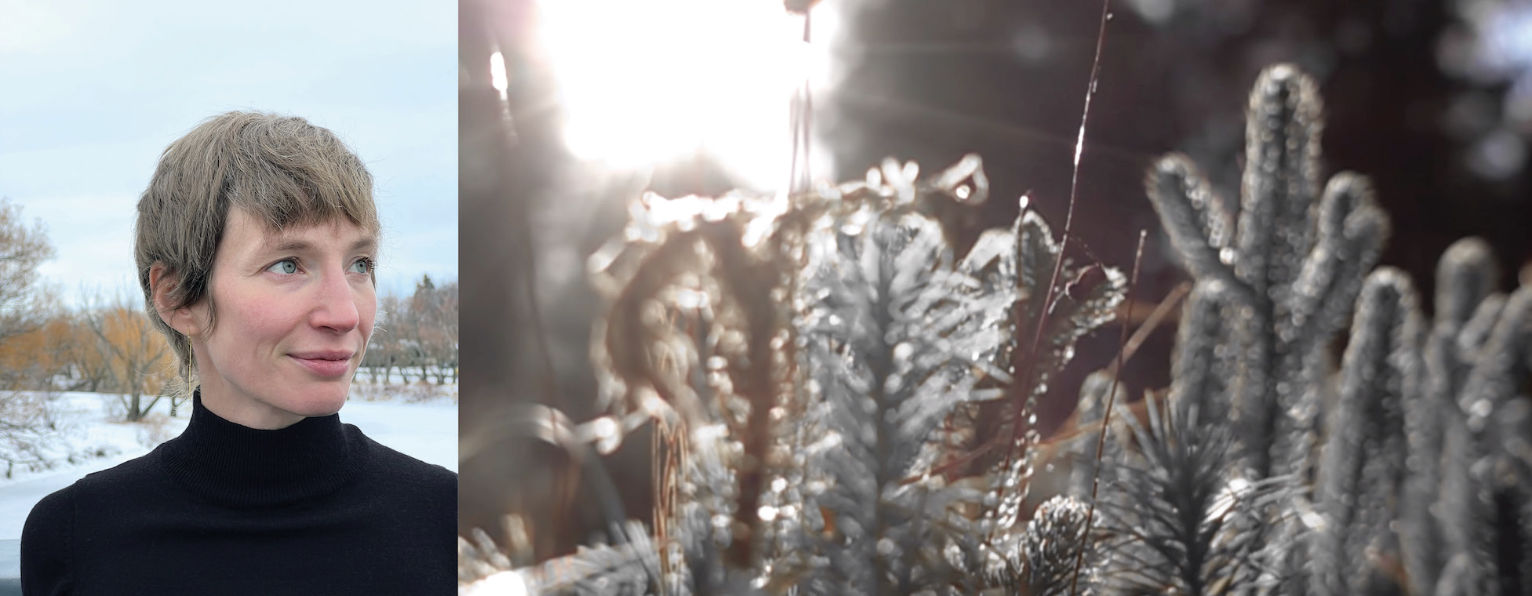More-than-human presents media artworks at the intersection of art, science, Indigenous worldviews, and technology that speculatively and poetically use multimodal storytelling as a vehicle for interpreting, mattering, and embodying more-than-human ecologies. The artworks in this exhibition aim to critically and emotionally engage with the important work of decentering the human and rethinking the perspective that sees nature as a lifeless resource for exploitation. Many of the artworks use technological and scientific tools as entry points for witnessing and interacting with these more-than-human worlds, as they help visualize phenomena beyond human sensory perception while nevertheless situating us within them. Combined, the artworks in the show weave a story that tells a tale of symbiosis, intersections, and more-than-human relationality. They incorporate scientific, philosophical, and Indigenous perspectives to create an experiential tapestry that asks the viewer to reconsider, reorient, and rethink relationships with the more-than-human.
It’s curated by Jane Tingley and is core exhibition of the CONTACT Photography Festival . Following is the Online Exhibition Publication.
more-than-human curator and artist:
Image Left to Right: Headshot of Jane Tingley. Jane Tingley with Faadhi Fauzi and Ilze (Kavi) Briede, (ex)tending towards, 2023, 3D visualization, cork, electronics, earth, point cloud. Photo by Jane Tingley.
Jane Tingley is an artist, curator, Director of the SLOlab: Sympoietic Living Ontologies Lab and Associate Professor at York University. Her studio work combines traditional studio practice with new media tools - and spans responsive/interactive installation, performative robotics, and telematically connected distributed sculptures/installations. Her works is interdisciplinary in nature and explores the creation of spaces and experiences that push the boundaries between science and magic, interactivity, and playfulness, and offer an experience to the viewer that is accessible both intellectually and technologically. Using distributed technologies, her current work investigates the hidden complexity found in the natural world and explores the deep interconnections between the human and non-human relationships. As a curator her interests lie at the intersection art, science, and technology with a special interest in collaborative creativity as impetus for innovation and discovery.
more-than-human artists:
Image Left to Right: Ursula Biemann. Ursula, Biemann, Forest Mind, 2021, sync 2-channel video installation, 31 minutes.
Ursula Biemann - an artist, author and video essayist. Her artistic practice is research oriented and involves fieldwork from Greenland to Amazonia, where she investigates climate change and the ecologies of oil, ice, forests and water. In her multi-layered videos, she interweaves vast cinematic landscapes with documentary footage, science fiction poetry and academic findings to narrate a changing planetary reality. In 2018, Biemann was commissioned by Museo de Arte, Universidad Nacional de Colombia in the co-creation of a new Indigenous University in the South of Colombia led by the Inga people in which she contributes the online platform Devenir Universidad.
Image Left to Right: Headshot of Lindsey french. Lindsey french, Phytovision, 2018-2019
Lindsey french - (she/they) is a settler artist, educator and writer whose work engages in multi- sensory signaling within ecological and technological systems. She has exhibited widely including at the Museum of Contemporary Art (Chicago), the International Museum of Surgical Science (Chicago), Pratt Manhattan Gallery (New York), the Miller Gallery for Contemporary Art (Pittsburgh), and SixtyEight Art Institute (Copenhagen). Recent publications include chapters for Ambiguous Territory: Architecture, Landscape, and the Postnatural (Actar, 2022), Olfactory Art and The Political in an Age of Resistance (Routledge, 2021), Why Look at Plants (Brill, 2019), and poetry for the journal Forty-Five. They earned an interdisciplinary BA in Environment, Interaction, and Design (Hampshire College), and an MFA in Art and Technology Studies (School of the Art Institute of Chicago)
Image left to right: Headshot of Grace Grothaus. Grace Grothaus, Drawing, 2022, envirographic video installation.
Grace Grothaus - Is a computational media artist whose research explores ecosystemic human and plant relationships in relation to the present global climate crisis and speculative futures. She is interested in art’s potential to foster empathy with more-than-human worlds. Frequently collaborative, Grace works with scientists, engineers, musicians and other visual and performing artists. Her research-creation is expressed as physical computing installations which take place both outdoors or in the gallery and often center around the sensing and visualization of invisible environmental phenomena. Her artworks have been exhibited widely including at the International Symposium of Electronic Art (Barcelona, ES & Durban, SA), Environmental Crisis: Art & Science (London, UK), Cité Internationale des Arts (Paris, FR), and the World Creativity Biennale (Rio de Janiero, BR). Grothaus has received numerous awards including from the United States National Foundation for Advancement in the Arts. Currently she is working towards a PhD in Digital Media from York University where she has been named a VISTA scholar and a Graduate Fellow of Academic Distinction.
Top Image Left to Right: Dolleen Tisawii’ashii Manning and Mary Bunch. Bottom Image: Dolleen Tisawii’ashii Manning and Mary Bunch, Emerging from the Water (beta version), 2022, virtual reality. Photo by Dolleen Tisawii’ashii Manning
Dolleen Tisawii’ashii Manning & Mary Bunch - Dolleen Tisawii’ashii Manning is an interdisciplinary artist and Queen’s National Scholar in Anishinaabe Language, Knowledge, and Culture (ALKC) in the Department of Philosophy and Cultural Studies at Queen’s University. Manning has expertise in Anishinaabe ontology, mnidoo interrelationality, phenomenology, and art. A member of Kettle and Stoney Point First Nation, her primary philosophical influence and source of creativity is her early childhood grounding in Anishinaabe onto- epistemology. She is Principal Investigator of Earthdiver: Land-Based Worlding (MITACS), and Co-Investigator on Pluriversal Worlding with Extended Reality. Manning co-directs the cross- institutional Peripheral Visions Co-Lab (York and Queen’s). She is an affiliate of Revision Centre for Art and Social Justice, and Fellow of The International Institute for Critical Studies in Improvisation (IICSI). Mary Bunch is a media artist, Canada Research Chair, and Associate Professor, Cinema and Media Arts at York University. Through theoretical inquiry and collaborative research creation, Bunch mobilizes queer, feminist, disability and decolonial frameworks to better understand peripheral worldmaking imaginaries in media arts and intermedial performance. She is co-editor of a special issue on Access Aesthetics in Public, Principal Investigator on the research creation project Pluriversal Worlding with Extended Reality (SSHRC Insight) and co-investigator on Earthdiver: Land- Based Worlding (MITACS). Dr Bunch is co-director of the Peripheral Visions Co- Lab, Executive Committee member of Sensorium: Centre for Digital Arts and Technology, a core member of Vision: Science to Applications (VISTA), a Fellow at the Bonham Centre for Sexual Diversity Studies, and an Affiliate of Revision Centre for Art and Social Justice.
Image Left to Right: Headshot of Suzanne Morrissette. Suzanne Morrissette, one and the same, 2016, interactive installation with Kinect and MAX. Image by Toni Hafkenscheid
Suzanne Morrissette - (she/her) (she/her) is an artist, curator, and scholar who is currently based out of Toronto. Her father’s parents were Michif- and Cree-speaking Metis with family histories tied to the Interlake and Red River regions and Scrip in the area now known as Manitoba. Her mother’s parents came from Canadian-born farming families descended from United Empire loyalists and Mennonites from Russia. Morrissette was born and raised in Winnipeg and is a citizen of the Manitoba Metis Federation. As an artistic researcher Suzanne’s interests include: family and community knowledge, methods of translation, the telling of in-between histories, and practices of making that support and sustain life. Her two recent solo exhibitions, What does good work look like? and translations recently opened in Toronto (Gallery 44) and Montreal (daphne art centre) respectively. Her work has appeared in numerous group exhibitions such as Lii Zoot Tayr (Other Worlds), an exhibition of Metis artists working with concepts of the unknowable, and the group exhibition of audio-based work about waterways called FLOW with imagineNATIVE Film + Media Art Festival. Morrissette holds a PhD from York University in Social and Political Thought. She currently holds the position of Assistant Professor and Graduate Program Director for the Criticism and Curatorial Practices and Contemporary Art, Design, and New Media Histories Masters programs at OCAD University.
Image Left to Right: Headshot of Joel Ong. Joel Ong, Untitled Interspecies Umwelten, 2021- photo still of live microscopic feed. Photo by Joel Ong.
Joel Ong - (PhD, MSc.Bioart) is a media artist whose works connect scientific and artistic approaches to the environment, developed from more than a decade of explorations in sound, installation and socially conscious art. His conceptual explorations revolve around metaphors of distance, connectivity, assiduously reworking this notion of the ‘environment’ - how different tools and scales of observation reveal diverse biotic and abiotic relationalities, and how these continually oscillate between natural and computational worlds. His works have been shown at internationally at the Currents New Media Festival, Nuit Blanche Toronto, Seattle Art Museum, the Gregg Museum of Art and Design, the Penny Stamps Gallery and the Ontario Science Centre etc. Joel is Associate Professor in Computational Arts and Director of Sensorium:The Centre for Digital Arts and Technology at York University, in Toronto, Canada. His research has been funded by such as SSHRC, eCampus Ontario, Women and Gender Equality Canada.
Top Image Left to Right: Raitis Smits & Rasa Smite. Bottom Image: Rasa Smite & Raitis Smits, Atmospheric Forest, 2020, immersive VR installation
Raitis Smits & Rasa Smite - are Riga and Karlsruhe based artists and co-founders of RIXC Center for New Media Culture in Riga, co-curators of RIXC Art and Science Festival, chief-editors of Acoustic Space, as well as co-chairs of recently founded NAIA - Naturally Artificial Intelligence Art association in Karlsruhe, Germany. Together they create visionary and networked artworks – from pioneering internet radio experiments in 1990s, to artistic investigations in electromagnetic spectrum and collaborations with radio astronomers, and more recent “techno-ecological” explorations. Their projects have been nominated (Purvitis Prize 2019, 2021, International Public Arts Award - Euroasia region 2021), awarded (Ars Electronica 1998, Falling Walls - Science Breakthrough 2021) and shown widely including at the Venice Architecture Biennale, Latvian National Museum of Arts, House of Electronic Arts in Basel, Ars Electronica Festival in Linz, and other venues, exhibitions and festivals in Europe, US, Canada and Asia. More recently they both also have been lecturers in MIT ACT - Art Culture Technology program (2018-2021), Boston. Rasa Smite holds a PhD in sociology of media and culture; her thesis Creative Networks. In the Rear-View Mirror of Eastern European History (11) has been published by The Amsterdam Institute for Network Cultures. Currently she is a Professor of New Media Art at Liepaja University, and Senior Researcher at FHNW Academy of Art and Design in Basel, Switzerland. Raitis Smits holds his doctoral degree in arts, and he is a Professor at the Art Academy of Latvia. In 2017 Raitis was a Fulbright Researcher in the Graduate Center of NYC.








